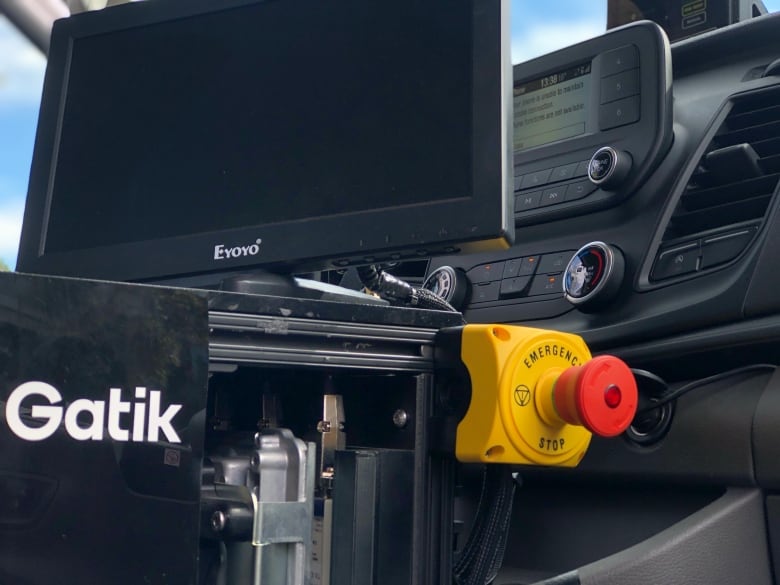Driverless grocery delivery one step closer to reality, after new program by Gatik and Loblaws | CBC News
Loblaws is partnering with an American autonomous vehicle company in what’s believed to be a Canadian first: taking grocery delivery orders between various Loblaws facilities via self-driving trucks.
There is no human sitting in the driver’s seat of a half-dozen trucks adorned with PC Express branding, currently making their way around various Ontario roadways.
It’s the latest step in a pilot program launched in 2020 in which trucks operated by Palo Alto, Calif.,-based Gatik ferried various items between Loblaws distribution hubs and a half-dozen retail locations across the Greater Toronto Area.
Although the trucks drive themselves, at first, a safety driver sat behind the wheel. More than 150,000 such trips were quietly done during the pandemic, and after completing all of them without a single safety incident, the two parties decided to take the next step: They sought and received permission from the province to go driverless, though they plan to have the safety driver sit in the passenger seat for now.
If all goes well, the safety driver may one day be removed from the vehicle entirely. While the trucks won’t be showing up on customer doorsteps any time soon, drivers will likely see the white trucks with a purple stripe and the words “Groceries on the go” out and about.
Check out this look from inside the first driverless commercial vehicle approved for use on Canadian roads, part of a pilot program by Loblaws and autonomous vehicle company Gatik.
Gatik and others have made similar partnerships with various companies in Texas, Arkansas and Louisiana, but the plan is thought to be a Canadian first.
“Gatik is the first autonomous trucking company operating across multiple sites in a commercial capacity with multiple customers, in a fully driverless fashion,” CEO Gautam Narang told CBC News in an interview.
CBC News reached out to transport agencies from every province and territory, and aside from Ontario none would confirm that they have given approval for a similar program anywhere else in the country.
The trucks are equipped with climate-controlling technology that allows them to handle room-temperature items, along with things that need to be refrigerated and frozen.
‘Middle mile’ of supply chain
While Loblaws is pleased with how the program has gone, customers shouldn’t soon expect the trucks to pull up at their front doors.
“We’ve really decided to focus, especially in autonomous, on the middle mile,” said David Markwell, Loblaws’ chief technology officer. “It’s a bit more manageable because you’re going on a fixed route between locations.”
That’s by design, as that’s the section of the supply chain that Narang says has the biggest gap.

There has been a lot of hype about self-driving trucks for long-haul trips on highways, because they tend to have more predictable traffic patterns. And drone technology has tended to focus on the so-called “last mile,” or delivering small packages from hubs to customers’ doors. But Gatik is targeting the middle of that supply chain by following fixed, repetitive and predictable routes, where the autonomous driving rubber has, for the most part, yet to hit the road.
“We have the luxury of choosing the best possible routes, the safest possible routes,” said Narang. “What I mean by that is it’s OK for our truck to take three right turns instead of an unprotected left turn. That’s one of the trickiest situations that the [autonomous vehicle] industry is trying to solve.”
‘Point A to point B’
Amir Khajepour, a professor of mechanical engineering at the University of Waterloo, says there are many reasons to be cautious about using fully autonomous vehicles, but, to him, this initiative sounds like a good example of solving a temporary problem today, as the transportation system transitions.
“We should be able to use this technology in those cases that we are definitely short in human activity and manpower,” he said in an interview.
A truck on a fixed route, on a fixed schedule is a great use for the technology, he says, precisely because it’s the type of task that can be done safely and efficiently.
“It goes from point A to point B, it’s limited in terms of the type of decisions that the car is going to make,” he said.
“If there is a blockage, the vehicle is going to stop.… A human driver can easily assess the risk and then, if necessary, make a lane change or do something in order to pass that blockage. But this vehicle is going to stop and then request for a human intervention remotely.”
That’s a far cry from the far-off future imagined by science fiction, one where an autonomous vehicle is delivering things to humans throughout every step of the supply chain.
Until the technology is able to completely replicate the complex nuances of human thought, said Khajepour, “it should be a long, long time” before fully autonomous deliveries are attempted. “I don’t think that we are there.”
For all the latest business News Click Here

